“But I will not live by ordinary standards. I will not run with the pack. I will not be chained into a routine of living which is the same for others. I will not look to the ground and move on the ground with the rest, so long as there are those mountain tops, and clouds, and limitless space.” —Nicholas Van Ryn
As everyone knows, Dragonwyck was the movie-goer’s introduction to Vincent Price in the persona that would make him one of the masters of the macabre—and the genre where he reigned supreme for forty-five years. Better yet, for him, it was the kind of film he most enjoyed making. Although Vincent Price played second fiddle to Boris Karloff and Basil Rathbone in The Tower of London—not technically a horror film as often assumed—his Duke of Clarence, drowned in a vat of wine, was an intimation, unformed, of the types of roles the actor would play during most of his career.
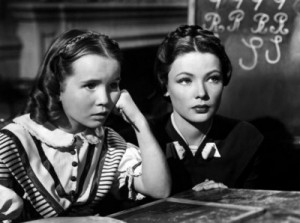 The mysterious goings-on, including murder, at a mysterious old house in the Hudson Valley during the 1840s, the dark setting of Dragonwyck, involve its master, a malevolent Nicholas Van Ryn. Price’s role here is the precursor of Professor Jarrod in House of Wax, Frederick Loren in House on Haunted Hill, Sir Markham in The Oblong Box and other demented homeowners in the Roger Corman-Edgar Allan Poe films, including The Pit and the Pendulum, The Tomb of Ligeia, The Masque of the Red Death and his ultimate lord of the manor role as Roderick Usher—my favorite—in The Fall of the House of Usher.
The mysterious goings-on, including murder, at a mysterious old house in the Hudson Valley during the 1840s, the dark setting of Dragonwyck, involve its master, a malevolent Nicholas Van Ryn. Price’s role here is the precursor of Professor Jarrod in House of Wax, Frederick Loren in House on Haunted Hill, Sir Markham in The Oblong Box and other demented homeowners in the Roger Corman-Edgar Allan Poe films, including The Pit and the Pendulum, The Tomb of Ligeia, The Masque of the Red Death and his ultimate lord of the manor role as Roderick Usher—my favorite—in The Fall of the House of Usher.
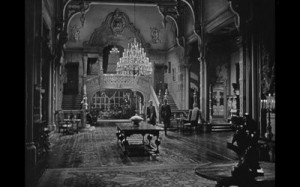 Among Gothic novels, or haunted house stories, the obvious movie transfers that come immediately to mind are Alfred Hitchcock’s Rebecca and the Orson Welles-Joan Fontaine version of Jane Eyre. Truth is, Gothic literature—primarily British, I’m thinking of now—goes back at least as far as Horace Walpole’s The Castle of Otranto (1764) and his contemporary, the then sensational Ann Radcliffe whose The Mysteries of Udolpho, as novelist-critic Walter Allen wrote, “has become almost the stock example of the Gothic novel . . . ” Jane Eyre was published in 1847.
Among Gothic novels, or haunted house stories, the obvious movie transfers that come immediately to mind are Alfred Hitchcock’s Rebecca and the Orson Welles-Joan Fontaine version of Jane Eyre. Truth is, Gothic literature—primarily British, I’m thinking of now—goes back at least as far as Horace Walpole’s The Castle of Otranto (1764) and his contemporary, the then sensational Ann Radcliffe whose The Mysteries of Udolpho, as novelist-critic Walter Allen wrote, “has become almost the stock example of the Gothic novel . . . ” Jane Eyre was published in 1847.
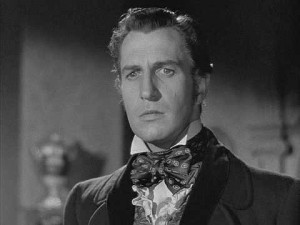 Gothic elements surface even in Charles Dickens in Miss Havisham’s house in Great Expectations and in Robert Louis Stevenson’s crumbling House of Shaws in Kidnapped with Uncle Ebenezer’s dangerous, uncompleted tower. Yes, there are other famous literary towers and secured rooms. In Jane Eyre, there’s the locked tower where Mr. Rochester keeps his mad wife, in Rebecca the forbidden boat house and in Dragonwyck the tower where Van Ryn satisfies his drug habit. “What can you possibly do up there?” his first wife asks. Drugs—opium in this case—are central in Dickens’ last, unfinished novel, The Mystery of Edwin Drood, essentially a murder mystery but with horror overtones.
Gothic elements surface even in Charles Dickens in Miss Havisham’s house in Great Expectations and in Robert Louis Stevenson’s crumbling House of Shaws in Kidnapped with Uncle Ebenezer’s dangerous, uncompleted tower. Yes, there are other famous literary towers and secured rooms. In Jane Eyre, there’s the locked tower where Mr. Rochester keeps his mad wife, in Rebecca the forbidden boat house and in Dragonwyck the tower where Van Ryn satisfies his drug habit. “What can you possibly do up there?” his first wife asks. Drugs—opium in this case—are central in Dickens’ last, unfinished novel, The Mystery of Edwin Drood, essentially a murder mystery but with horror overtones.
Spooky old houses materialize among American writers, too—in Nathaniel Hawthorne’s The House of Seven Gables (1851) and Herman Melville’s substitution of a ship, the “Piquod,” for a house in Moby Dick (also 1851). Poe, as already suggested by the Corman films, transferred his psychotic, macabre life to literature in any number of tales—The Tell-Tale Heart, The Black Cat as well as The Fall of the House of Usher.
The New York born Anya Seton continued the Gothic tradition into the last century with Dragonwyck. She wrote for some thirty-five years, beginning in 1941 with My Theodosia and ending in 1975 with Smouldering Fires, and, in between, two of her novels were made into films, Dragonwyck in 1946 and Foxfire, with Jane Russell and Jeff Chandler, in 1955.
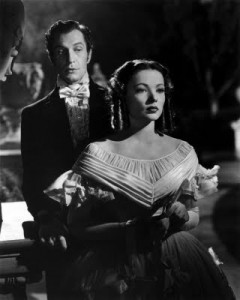 The great cinematographer Arthur Miller’s first shot of Dragonwyck, a matte painting with a low perspective to emphasize the great house’s enormity, is accompanied by a brilliant outburst from Alfred Newman’s orchestra. It is one of the composer’s few chances to be loud and up front—rarely “upbeat” in this film—as much of his music, dark and foreboding, is unfortunately submerged beneath endless dialogue; if sometimes awkward and unnatural, the talking is full of clues. This is, indeed, one of those movies where the viewer needs to pay attention.
The great cinematographer Arthur Miller’s first shot of Dragonwyck, a matte painting with a low perspective to emphasize the great house’s enormity, is accompanied by a brilliant outburst from Alfred Newman’s orchestra. It is one of the composer’s few chances to be loud and up front—rarely “upbeat” in this film—as much of his music, dark and foreboding, is unfortunately submerged beneath endless dialogue; if sometimes awkward and unnatural, the talking is full of clues. This is, indeed, one of those movies where the viewer needs to pay attention.
This shot of Dragonwyck, however, appears well into the film, after Miranda Wells (Gene Tierney) has been chosen over her sister by her parents to accept an invitation from a distant cousin, Van Ryn, for one of their daughters to stay with his family at the estate.
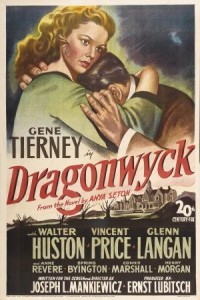
One thought to “Dragonwyck (1946) with Gene Tierney”